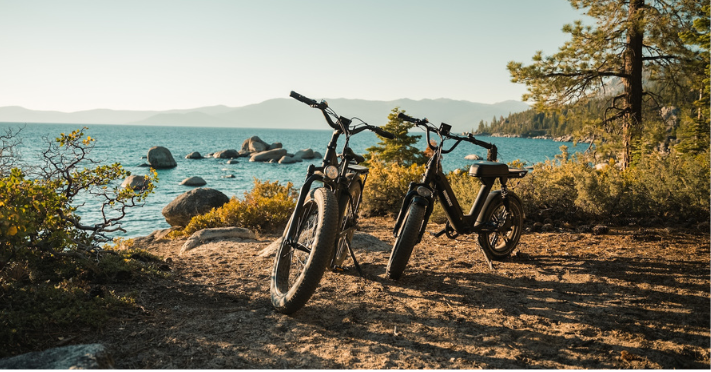Fat-tire electric bikes are rapidly gaining popularity as they provide a comfortable ride while taking on challenging terrain like dirt, mud, sand, and snow. A fat-tire e-bike is equipped with oversized tires that allow riders to easily go off-road for activities like camping, fishing, and hunting. Fat-tire e-bikes can also be used for commuting to work or running errands in town.
These bikes are supported by a motor that helps riders cover more distance with less effort than required by traditional bicycles. The best fat-tire e-bikes feature high-performance motors and batteries that offer a high top speed and long range per charge. If you’re thinking about choosing between an e-bike with narrower tires or one with fat rubber, this guide will help you make your decision.
What Are Fat-Tire E-bikes?
A fat-tire e-bike features oversized tires that deliver maximum stability on tricky, uneven, or loose terrain. “Fat” tires are around twice as wide as tires on regular bikes – typically 4” or more.
As a result, and thanks to their robust design, fat tire e-bikes are ideally suited to off-road riding. However, their extra stability and, at lower air pressures, tire flotation make them perfect for just about any terrain, from sand to paved bike paths.
Considering fat- versus traditional-tire e-bikes, a fat-tire bike will typically come with 4” tires 4 to 5 inches wide. Most can be inflated from anywhere between 5 psi (pounds per square inch) to 30 psi to meet diverse surface conditions. A 30 psi tire is well-suited to tarmac and pavements, while a lower psi is ideal for increased surface contact on soft surfaces like sand and snow. To compare fat versus traditional bike tires, a regular e-bike will be fitted with tires ranging from 1.95” to 3” wide.
Fat-tire e-bikes also come in various shapes and types, from foldable and step-through frames to more common diamond-frame mountain bikes. And these bikes offer multiple benefits for e-bike riders.
What Are the Benefits of Fat-Tire E-bikes?
The primary benefit of fat-tire e-bikes is their ability to tackle uneven or unruly terrain in any weather condition. The wide tires offer extra grip and traction, enabling you to take on off-road challenges that would be too difficult for regular bikes and tires.
The benefits of riding fat-tire electric bikes include:
Ride anywhere: The oversized tires on fat-tire e-bikes break the limits on the types of terrain you can ride. The extra-wide tires significantly enhance balance and stability on tricky terrain like mud, sand, and snow. As a result, you now have the option to stick a pin in a map and ride anywhere.
Ride in any weather: A vital difference between fat- and traditional-tire e-bikes is the weather conditions they allow riders to handle. Adverse conditions are likely to impact the performance of a regular tire, causing the tire to bog down in the mud or skid in heavy rain. But there are no such problems with fat tires, which can tackle all sorts of weather. So a fat-tire e-bike will deliver optimal levels of balance and control in the heaviest of downpours, snow, and thick mud.
Maximum versatility: Fat-tire e-bikes are equally adept at handling adverse conditions as they are smooth roads and paved paths. And it’s this versatility and ability to adapt to all situations that make these vehicles a great all-around option. Heavy-duty fat tires deliver the same level of comfort and stability for the commute to work or cruising around town, making them ideal bikes for all purposes.
A comfortable ride guaranteed: The extra rubber that fat-tire e-bikes roll on ensures a comfortable ride as it absorbs shocks and vibrations. The fat tires deliver additional comfort and easy-riding experiences on long stretches of road and rugged or bumpy trails. And the larger tires offer greater stability, helping even new riders feel more confident on two wheels no matter the surface condition.
Durability: Top-quality fat-tire e-bikes are built to last, making you less likely to encounter maintenance problems. This is a crucial advantage over standard tires, which are prone to issues around punctures or suffering flat tires on rough terrain or potholes.
Massive amounts of fun: A critical benefit of riding a fat-tire electric bike is the enormous amount of fun you’ll have with it. The fat tires can handle any terrain thrown at them, enabling you to tackle muddy trails, snowy mountain paths, dusty and bumpy routes, and even sand dunes. These bikes really can maximize the amount of fun you can have on two wheels.
Fitness benefits: Despite having a motor to reduce the effort required to tackle steep hills and provide extra zip along smooth roads, fat-tire e-bikes also help you improve your fitness. A common misconception is that e-bikes cheat on fitness and offer fewer health benefits than regular bikes. But studies have found that, thanks to the addition of a motor, battery, and pedal assist, e-bike riders tend to travel farther and exercise for longer durations. Furthermore, fat-tire e-bikes can require a little more effort to pedal than e-bikes with narrower tires, which delivers additional fitness benefits.
Additional Fat-Tire E-bike Considerations
Before going out and purchasing a fat-tire e-bike, consider the following factors:
Non-transferable wheels and tires: If you’re thinking of swapping the plus-size wheels of your fat tire e-bike onto a non-fat bike, then unfortunately you’re out of luck. The 4”-plus tires typically won’t fit onto other bikes as they are too wide. However, it is possible to fit regular mountain bike wheels on a fat-tire electric bike, provided that the hub spacing is not different.
Price: Fat-tire electric bikes might cost a little more than you’re accustomed to with regular bikes. For example, the lowest-priced bike in our guide to the best fat-tire electric bikes was the Nakto Santa Monica Fat Tire at $1,099.99, and the most expensive was QuietKat’s Apex Pro at $5,499. But you’re likely looking at anywhere between $1,500 and $3,000 for a good-quality fat-tire electric bike.
Conquer All Terrains With a Fat-Tire E-bike
Fat-tire e-bikes enable riders to cover a wide range of terrain and enjoy two-wheeled action in all weather conditions. They deliver excitement, exercise, and fun while enhancing balance and stability.



